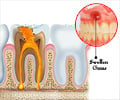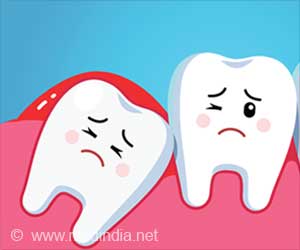Atom probe tomography and electron microscopy imaging of the enamel of the tooth revealed tiny chemical flaws. Findings could help prevent or reverse tooth decay.

‘Tooth enamel when imaged using complementary imaging techniques like atom probe tomography and electron microscopy, exposed chemical flaws exposed tiny chemical flaws. These findings key to prevent or reverse tooth decay.’
Read More..




The paper’s co-lead authors are Northwestern doctoral student Karen DeRocher and postdoctoral researcher Paul Smeets. Read More..
Thanks to its high mineral count, tooth enamel is a sturdy substance that can withstand the rigors of chewing, although excessive acid in the mouth can make it vulnerable to decay.
While scientists have previously peeked into the crystallites that compose enamel, nanoscale images of its structure and chemical composition have been harder to come by. In one method, scanning transmission electron microscopy, or STEM, a beam of electrons is shot through a sample. But that process has its limits.
“Enamel is mechanically a very, very strong material, but when you put it in the electron microscope, it’s very sensitive to the electron beam,” Kourkoutis said. “So compared to the crystalline materials that you find in electronics, for example, you can only put a fraction of the number of electrons into an enamel crystal. Normally, pushing down to the atomic scale means you have to put more electrons into the material. But if it damages the material before you get the information out, then you’re lost.”
In recent years, Joester’s Northwestern group has imaged sensitive biological materials with atom probe tomography, a process that essentially strips atoms off a sample’s surface one at a time and reconstructs the structure of the material.
Advertisement
“When you operate at low temperature, the material becomes more robust against electron beam damage,” said Kourkoutis, who directs PARADIM’s electron microscopy facility. “We are now working at the intersection between the developments in the physical sciences which have pushed electron microscopy to the atomic scale and the developments in the life sciences in the cryogenic field.”
Advertisement
Smeets worked with Kourkoutis’ doctoral students Berit Goodge and Michael Zachman, Ph.D., co-authors of the new paper. The group performed cryogenic electron microscopy on enamel samples that were cooled with liquid nitrogen to around 90 kelvins, or minus 298 degrees Fahrenheit.
By combining their complementary techniques, the Cornell and Northwestern researchers were able to image an enamel crystallite and its hydroxylapatite atomic lattice. But all was not crystal clear: The lattice contained dark distortions – caused by two nanometric layers with magnesium, as well as sodium, fluoride and carbonate ion impurities near the core of the crystal.
Additional modeling confirmed the irregularities are a source of strain in the crystallite. Paradoxically, these irregularities and the enamel’s core-shell architecture may also play a role in reinforcing the enamel, making it more resilient.
The researchers say the findings could lead to new treatments for strengthening enamel and combating cavities.
“On the foundation of what we discovered, I believe that atom probe tomography and correlative electron microscopy will also have tremendous impact on our understanding of how enamel forms, and how diseases like molar incisor hypomineralization disrupt this process,” Joester said.
And mouths aren’t the only beneficiaries of cryogenic electron microscopy. Kourkoutis is also using the process to probe the chemistry in energy systems, such as batteries and fuel cells that contain a mix of soft electrolytes and hard electrode materials.
Co-authors include researchers from Northwestern University and the University of Virginia.
The research was supported by the National Institutes of Health’s National Institute of Dental and Craniofacial Research, the National Science Foundation and the University of Virginia.
Source-Newswise













